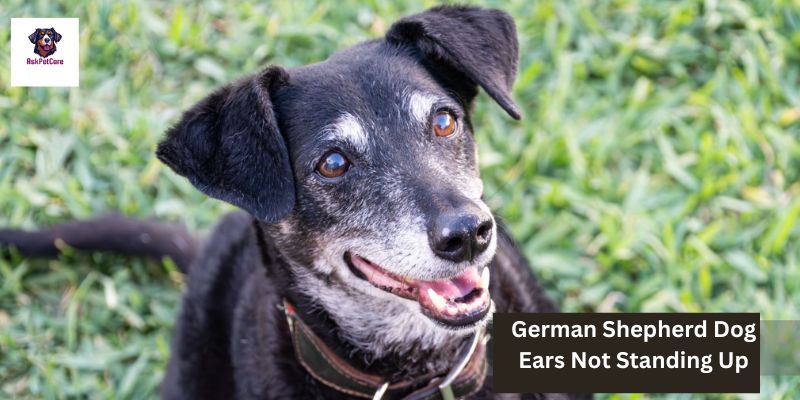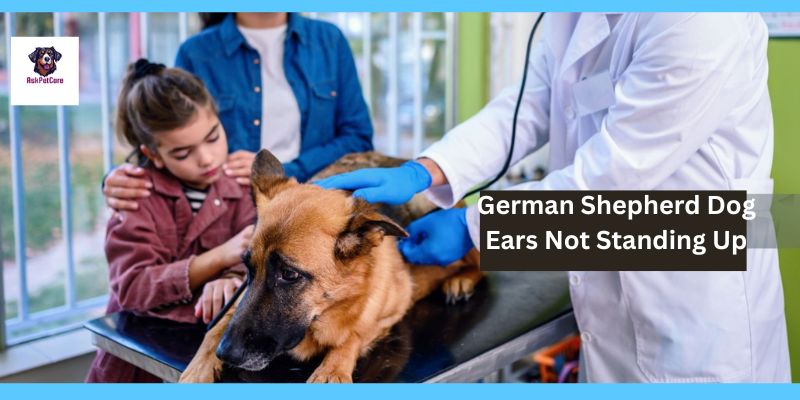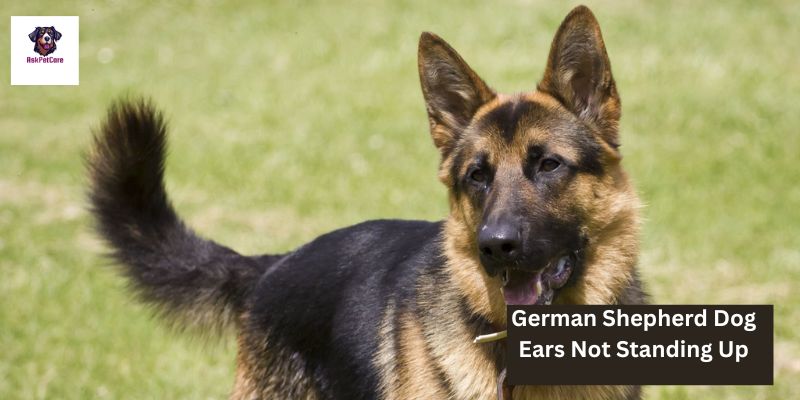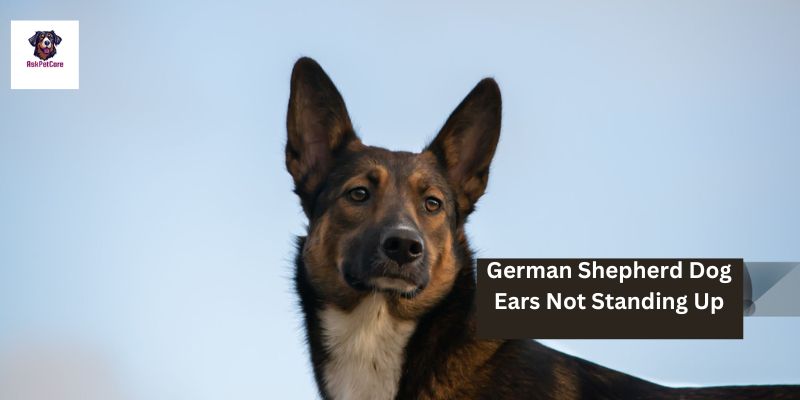Discover the reasons behind German shepherd dogs’ ears not standing up as expected
Hello GSD Lovers today I will explain in detail Why German Shepherd Dog Ears Not Standing Up.
- German Shepherd dogs are well-known for their noble appearance, intelligence, and loyalty. One of their distinguishing features is their erect ears, which stand tall and proud, adding to their majestic appearance. These dogs have a rich history, originally bred as herding and working dogs, and have since become beloved companions and versatile working partners in various roles, including police, military, search and rescue, and therapy.
- Despite their iconic erect ears, German Shepherds can sometimes experience ear problems, with one common issue being ears that do not stand up as expected. This condition, known as “floppy ears” or “soft ears,” can be concerning for owners who expect their German Shepherd’s ears to stand erect. While this may not affect the dog’s health, it can impact their appearance and breed standard. Understanding the reasons behind ears not standing up is crucial for owners to address any potential concerns and ensure their dog’s well-being.

Hello everyone who loves dogs! I’m Dr. Arif Aziz, and I’ve been taking care of pets especially dogs at my clinic for a long time, exactly 14 years! I’m here to share some valuable information with you that I’ve gathered from books during my study time written by experts in veterinary medicine (DVM) and MSC (Master of Science), as well as from my own experiences working with dogs.
Firstly Understanding German Shepherd ears:
Here I will explain the bread standard for GSD ears and the significance of erect rears and also discuss the factors that contribute to ears not standing up.
- German Shepherds are recognized for their erect ears, which are an essential characteristic according to the breed standard. These ears are an integral part of the breed’s appearance, giving them a confident and alert expression. Erect ears contribute to the German Shepherd’s overall noble and commanding presence. In dog shows and competitions, the proper ear position is evaluated to ensure adherence to breed standards and showcase the breed’s desired characteristics.
- Several factors can influence why German Shepherd ears may not stand up as expected. Genetics play a significant role, as puppies inherit ear shape and position traits from their parents. Additionally, during the teething process, which typically occurs around 3 to 6 months of age, puppies may experience temporary changes in ear position due to the shifting and growth of cartilage and muscles. Proper ear development is also essential, and any disruptions or abnormalities during this process can affect ear position. By understanding these factors, owners can better comprehend why their German Shepherd’s ears may not stand up and take appropriate steps to address any concerns.

Firstly understand seven factors that can influence why German shepherd dog ears not standing up:
- Genetics: The most significant factor influencing ear position in German Shepherds is genetics. Ear shape and position traits are inherited from the puppy’s parents. If one or both parents have floppy ears or a history of producing offspring with ear issues, there’s a higher likelihood that the puppy’s ears may not stand up properly.
- Teething: During the teething process, which typically occurs between 3 to 6 months of age, puppies may experience temporary changes in ear position. This is because the growth and shifting of teeth can affect the surrounding cartilage and muscles in the ears, causing them to droop temporarily.
- Ear Development: Proper ear development is crucial for achieving erect ears in German Shepherds. Any disruptions or abnormalities during the critical growth phase of the ears can impact their ability to stand up. Factors such as poor nutrition, trauma, or infections during puppyhood can affect ear development and contribute to ear issues.
- Ear Infections: Ear infections, particularly those affecting the inner or middle ear, can cause inflammation and discomfort, leading to droopy ears. Chronic or recurrent ear infections can damage the structures within the ear and hinder proper ear positioning.
- Ear Trauma: Trauma to the ears, such as rough handling, excessive scratching, or injuries from other animals, can damage the delicate cartilage and muscles responsible for holding the ears upright. In severe cases, trauma can lead to permanent changes in ear shape and position.
- Ear Mites: Infestations of ear mites, tiny parasites that inhabit the ear canal, can cause irritation, inflammation, and itching, leading to excessive scratching and ear drooping. Treating ear mite infestations promptly can help prevent long-term damage to the ears.
- Ear Care Practices: Improper ear care practices, such as excessive cleaning or taping, can interfere with natural ear development and exacerbate existing ear issues. It’s essential to follow veterinary recommendations for ear care and avoid unnecessary interventions that may disrupt ear health.
Understanding these factors can help German Shepherd owners identify potential issues with their dog’s ears and take appropriate measures to address them, such as consulting with a veterinarian for guidance on ear care and management.

Now I Explain Tips For Encouraging Ear Standing In German Shepherd Puppies:
- Proper Nutrition: Providing a balanced and nutritious diet is essential for supporting overall health and proper ear development. Ensure that your puppy receives adequate amounts of protein, vitamins, and minerals, which are crucial for strong muscles, cartilage, and connective tissues in the ears. Consult with your veterinarian to select a high-quality puppy food that meets your puppy’s specific nutritional needs.
- Calcium and Phosphorus Balance: Calcium and phosphorus are essential minerals for bone and cartilage formation, including the ears. Ensure that your puppy’s diet contains an appropriate balance of calcium and phosphorus to support healthy bone growth without causing imbalances or deficiencies. Avoid over-supplementing these minerals, as excessive levels can disrupt proper bone development and lead to skeletal issues.
- Ear Taping: Ear taping is a technique used to train the ears to stand up properly during the critical growth phase. It involves gently manipulating the ears into the desired position and securing them with specialized tape or adhesive. Ear taping should be performed under the guidance of a veterinarian or experienced breeder to ensure it is done correctly and safely. Consistent and proper taping can help encourage ear muscles to strengthen and ears to stand up over time.
- Ear Massage: Gentle massage of the ears can help stimulate blood flow, improve muscle tone, and promote ear health. Use your fingertips to massage the base of your puppy’s ears in circular motions, working from the base to the tip. Avoid applying excessive pressure or pulling on the ears, as this can cause discomfort or injury.
- Regular Exercise: Providing regular exercise and physical activity for your puppy helps promote overall health and muscle development, including the muscles in the ears. Engage your puppy in age-appropriate activities such as walks, playtime, and training sessions to encourage strong and healthy ear muscles.
- Mental Stimulation: Mental stimulation is essential for keeping your puppy’s mind active and engaged, which indirectly supports ear health and development. Provide your puppy with interactive toys, puzzle games, and training exercises to stimulate their brain and encourage overall well-being.
- Patience and Consistency: Encouraging ear standing in German Shepherd puppies requires patience and consistency. Understand that each puppy develops at their own pace, and it may take time for ears to stand up fully. Be consistent with ear care practices, such as taping and massage, and avoid unnecessary interventions that may disrupt natural ear development. With patience and consistent efforts, many puppies can achieve proper ear standing as they mature.

Now I Explain When To Seek Veterinary Advice:
Signs of Concern: Several signs may indicate a more serious underlying issue with your German Shepherd’s ears, warranting veterinary attention. These signs include:
- Persistent ear drooping or lack of improvement in ear position despite efforts to encourage standing.
- Redness, swelling, or inflammation of the ears.
- Discharge or foul odor coming from the ears.
- Excessive scratching or rubbing of the ears.
- Head shaking or tilting.
- Sensitivity or pain when touching the ears.
- Changes in behavior, such as lethargy or decreased appetite, which may indicate discomfort or infection.
Importance of Veterinary Care: If you notice any of these signs or have concerns about your German Shepherd’s ears, it’s crucial to seek veterinary advice promptly. A veterinarian can perform a thorough examination of your dog’s ears to determine the underlying cause of any issues and recommend appropriate treatment. Early intervention is key to addressing ear problems effectively and preventing complications. Additionally, persistent issues with ear position or other symptoms may indicate underlying health issues that require medical attention. By consulting with a veterinarian, you can ensure that your German Shepherd receives the care and support they need to maintain healthy ears and overall well-being.

German Shepherd Puppy Ears Stages.
Certainly! German Shepherd puppy ears go through several stages of development as they grow and mature. Understanding these stages can help owners know what to expect and how to care for their puppy’s ears.
- Floppy Stage (0-6 weeks): When German Shepherd puppies are born, their ears are soft and floppy, as the cartilage in the ears has not yet fully developed or hardened. During the first few weeks of life, puppies rely on their mother’s milk for nourishment and care, and their ears remain folded over or droopy.
- Early Upright Stage (6-12 weeks): Around 6 weeks of age, German Shepherd puppy ears may start to show signs of standing up, although they may still be somewhat floppy or wobbly. This is due to the gradual hardening and strengthening of the cartilage in the ears. During this stage, puppies may go through periods where their ears stand erect for short periods before flopping back down.
- Teething Stage (3-6 months): Between 3 to 6 months of age, German Shepherd puppies begin teething, which can affect the position of their ears. The process of teething can cause temporary changes in ear position as the growth and shifting of teeth can impact the surrounding cartilage and muscles. During this stage, it’s common for puppy ears to appear more floppy or uneven as they go through growth spurts and dental changes.
- Adult Stage (6-12 months): By around 6 to 12 months of age, most German Shepherd puppies’ ears should be fully erect and standing upright. The cartilage in the ears has hardened and stabilized, allowing them to maintain their erect position permanently. However, some puppies may take longer for their ears to stand up completely, and it’s not uncommon for minor fluctuations in ear position during this transitional period.
Throughout these stages, owners need to provide proper nutrition, regular veterinary care, and gentle ear care to support healthy ear development. While most German Shepherd puppies’ ears will eventually stand up on their own, some may require additional support or intervention, such as ear taping, to encourage proper ear position. Monitoring your puppy’s ear development and seeking veterinary advice if you have concerns can help ensure that they grow up to have healthy and erect ears.
| Ear Development Stage | Description |
| Floppy Stage (0-6 weeks) | At birth, German Shepherd puppy ears are soft and floppy, with undeveloped cartilage. They rely on their mother for care and nourishment. |
| Early Upright Stage (6-12 weeks) | Around 6 weeks, ears may begin to show signs of standing up, though they may still be somewhat floppy. Cartilage starts to harden, but ears may still flop occasionally. |
| Teething Stage (3-6 months) | Between 3 to 6 months, teething begins, causing temporary changes in ear position due to the growth and shifting of teeth impacting surrounding cartilage and muscles. Ears may appear more floppy during this period. |
| Adult Stage (6-12 months) | By 6 to 12 months, most German Shepherd puppy ears should be fully erect and stable. Cartilage has hardened, allowing ears to maintain an upright position permanently. Some puppies may require longer ears to stand fully erect. |
Throughout these stages, proper nutrition, veterinary care, and gentle ear care support healthy development. While most puppies’ ears will stand up on their own, some may need additional support like ear taping. Monitoring and seeking veterinary advice if concerned ensures healthy ear development.

Is it bad if German shepherd ears don’t stand up?
When German Shepherd ears don’t stand up as expected, it’s not necessarily bad or harmful to the dog’s health, but it can be disappointing for owners who expect the breed’s iconic erect ears. German Shepherds are known for their erect ears, which contribute to their noble appearance and alert expression. However, some German Shepherds may have ears that remain floppy or only partially erect, which is known as “soft ears” or “floppy ears.”
In terms of health, floppy ears in German Shepherds do not typically pose any medical concerns. The function of the ears, such as hearing and ear protection, is not significantly affected by whether they stand up or remain floppy. However, in certain situations, floppy ears may be associated with an increased risk of ear infections or ear-related issues due to reduced airflow and ventilation within the ear canal. Additionally, in the context of breed standards and dog shows, floppy ears may be considered a deviation from the desired appearance of the breed, but this does not impact the dog’s health or temperament.
Overall, while it may be disappointing for owners who prefer the breed’s traditional erect ears, floppy ears in German Shepherds are not inherently harmful or detrimental to the dog’s well-being. However, if owners are concerned about their dog’s ear health or appearance, they can explore options such as ear taping or consulting with a veterinarian for advice on supporting ear health and development. It’s essential to remember that each dog is unique, and what matters most is their overall health, happiness, and well-being, regardless of the appearance of their ears.

German Shepherd Dog Ears Not Standing Up After Certain Age:
When German Shepherd dog ears don’t stand up as expected after a certain age, it can be a source of concern for owners who anticipate the breed’s iconic erect ears. German Shepherds are renowned for their upright ears, which add to their noble appearance and alert expression. However, sometimes a German Shepherd’s ears may remain floppy or only partially erect, which is known as “soft ears” or “floppy ears.”
There can be several reasons why a German Shepherd’s ears don’t stand up as expected. Genetics plays a significant role, as certain bloodlines may be predisposed to softer ears. Additionally, factors such as teething, ear infections, trauma, or improper ear care practices can also contribute to ear issues. During the critical growth phase, typically between 3 to 6 months of age, the ears should begin to stand up. However, if they fail to do so, it may indicate an underlying problem that requires attention.
While floppy ears in German Shepherds don’t usually pose a health risk, they may affect the breed’s appearance, particularly in the context of breed standards or dog shows. However, it’s essential to remember that a dog’s health and well-being are paramount, regardless of ear position. If a German Shepherd’s ears don’t stand up as expected, owners can explore options such as ear taping or consult with a veterinarian to address any potential underlying issues and ensure the dog’s overall health. With proper care and attention, many German Shepherds with floppy ears can lead happy and healthy lives.

Now I Explain Grown German Shepherd With Floppy Ears.
When a grown German Shepherd has floppy ears, it means that their ears have not developed to stand up as expected for the breed. German Shepherds are known for their iconic erect ears, which typically stand upright and add to their noble appearance. However, in some cases, a German Shepherd’s ears may remain floppy or only partially erect, which is often referred to as “soft ears” or “floppy ears.”
There can be several reasons why a grown German Shepherd may have floppy ears. Genetics plays a significant role, as certain bloodlines may be predisposed to softer ears. Additionally, factors such as teething, ear infections, trauma, or improper ear care practices during puppyhood can also contribute to ear issues that persist into adulthood.
While floppy ears in grown German Shepherds don’t usually pose a health risk, they may affect the breed’s appearance, particularly in the context of breed standards or dog shows. However, it’s important to remember that a dog’s health and well-being are the most important considerations, regardless of ear position. If a grown German Shepherd has floppy ears and it causes concern for the owner, they can explore options such as consulting with a veterinarian or a professional dog breeder to address any potential underlying issues and discuss potential solutions. With proper care and attention, many German Shepherds with floppy ears can lead happy and healthy lives.
Now I Explain German Shepherd Floppy Ears 9 Months.
When a German Shepherd has floppy ears at 9 months of age, it means that their ears have not yet fully developed to stand up as expected for the breed. German Shepherds are known for their characteristic erect ears, which typically stand upright and contribute to their regal appearance. However, in some cases, a German Shepherd’s ears may remain floppy or only partially erect, which is commonly referred to as “soft ears” or “floppy ears.”
There can be several reasons why a German Shepherd may have floppy ears at 9 months old. Genetics plays a significant role, as certain bloodlines may be predisposed to softer ears. Additionally, factors such as teething, ear infections, trauma, or improper ear care practices during puppyhood can also contribute to ear issues that persist into adolescence.
While floppy ears in a 9-month-old German Shepherd may not pose a health risk, they can affect the breed’s appearance, particularly in the context of breed standards or dog shows. However, it’s essential to prioritize the dog’s health and well-being over appearance. If the floppy ears cause concern for the owner, they can consult with a veterinarian or experienced breeder for guidance. With proper care and attention, many German Shepherds with floppy ears can still lead happy and healthy lives, even if their ears don’t stand up as expected.

Now I Explain How Taping German Shepherd Ears.
Taping German Shepherd ears is a technique used to encourage proper ear positioning during the critical growth phase when the ear cartilage is still soft and pliable. The goal of ear taping is to train the ears to stand up properly, as per the breed standard, by providing support and stability to the developing ear structure. Here’s a simple explanation of the taping process:
- Preparation: Before beginning the taping process, gather the necessary materials, including specialized adhesive tape or strips designed for ear taping, scissors, and possibly cotton balls or gauze pads. Ensure that the puppy’s ears are clean and dry before starting.
- Technique: Carefully manipulate the puppy’s ears into the desired upright position, ensuring that they are symmetrical and balanced. Starting at the base of the ear, apply a strip of tape horizontally across the ear, gently pulling the ear upward as you go. Continue wrapping the tape around the ear, overlapping slightly with each pass, until you reach the tip of the ear. Make sure the tape is snug but not too tight to avoid restricting blood flow.
- Securing: Once the ear is taped, secure the tape in place by pressing it firmly against the ear to ensure it adheres properly. Trim any excess tape with scissors to create a neat finish. Repeat the taping process for the other ear, ensuring consistency in positioning and technique.
- Monitoring: Check the taped ears regularly to ensure they remain clean, dry, and properly positioned. If the tape becomes soiled or starts to loosen, it may need to be replaced or adjusted. Avoid leaving the tape on for too long to prevent skin irritation or discomfort.
- Consultation: It’s essential to consult with a veterinarian or experienced breeder before starting the taping process to ensure it is done correctly and safely. They can guide the appropriate taping technique, duration, and frequency based on the puppy’s individual needs and ear development.
By following these steps and seeking professional guidance, owners can effectively tape their German Shepherd puppy’s ears to encourage proper ear positioning and support healthy ear development.
When should I worry about my German Shepherd’s ears not sticking up?
You should start to consider seeking advice from a veterinarian or experienced breeder if your German Shepherd’s ears have not started to stand up by around 5 to 6 months of age. While variations in ear development are normal during the early stages of growth, prolonged floppiness or inconsistency in ear position beyond this age could indicate potential issues that may require attention. Factors such as genetics, ear care practices, and overall health can influence ear development in German Shepherds. Consulting with a professional can help determine if there are any underlying concerns and provide guidance on how to support your dog’s ear health and development.
How do I get my German Shepherd’s ears to stand up?
Encouraging your German Shepherd’s ears to stand up typically involves techniques such as ear taping, which provides support and stability to the developing ear cartilage during the critical growth phase. Ear taping should be performed under the guidance of a veterinarian or experienced breeder to ensure it is done correctly and safely. Consistent and proper taping, along with other measures such as proper nutrition, regular veterinary care, and gentle ear massage, can help strengthen the ear muscles and promote proper ear positioning over time. However, it’s important to remember that not all dogs’ ears will stand up perfectly, and variations in ear position are normal within the breed.
What does it mean when my German Shepherd’s ears are down?
When a German Shepherd’s ears are down or floppy, it could indicate that the ear cartilage has not yet fully developed or hardened to support an upright position. This condition, often referred to as “soft ears” or “floppy ears,” is common in puppies during the early stages of growth when the ear cartilage is still soft and pliable. While floppy ears are not typically a cause for concern, especially in young puppies, prolonged floppiness or inconsistency in ear position as the dog matures may warrant further investigation by a veterinarian. Floppy ears can also be a temporary response to factors such as teething, ear infections, trauma, or improper ear care practices.
Why won’t my dog’s ears stand up?
There are several reasons why a dog’s ears may not stand up as expected. Genetics plays a significant role, as certain bloodlines may be predisposed to softer ears. Additionally, factors such as teething, ear infections, trauma, or improper ear care practices during puppyhood can also contribute to ear issues. During the critical growth phase, typically between 3 to 6 months of age, the ears should begin to stand up. However, if they fail to do so, it may indicate an underlying problem that requires attention. If your dog’s ears are not standing up as expected and it causes concern, it’s best to consult with a veterinarian for advice on how to support your dog’s ear health and development.
I hope you will thoroughly understand why GSD ears not stand up its reasons and how we can treat them.
Here are some reference books that are considered authoritative on the topic of dog care, including nail care:
- “The Complete Dog Owner’s Manual” by Dr. Bruce Fogle
- “The Ultimate Guide to Dog Care: Everything You Need to Know to Keep Your Dog Happy and Healthy” by Amy Marder and Andrew Luescher
